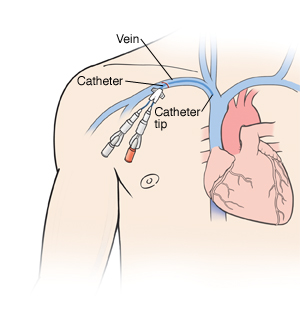Central Line Care
You need a central line as part of your treatment. It is a small, soft tube called a catheter. It is put in a vein that leads to your heart. A central line is often used instead of a standard IV (intravenous) line when you need treatment for longer than a week. The line can deliver medicine or nutrition right into your bloodstream. It can also be used to draw blood samples.
Infection free
Our goal is to see that this central line catheter stays infection free. We want it to be removed as soon as it is no longer needed.

What you can expect from the health care team caring for your central line:
-
Each nurse caring for you will check your central line for any signs of infection.
-
Everyone using your central line will wash their hands.
-
Before using the line, the blue connector at the end of the line will be scrubbed for at least 5 seconds with a new alcohol pad.
-
If you shower, the dressing must be covered to keep it dry.
-
While you are in the hospital, you will be asked to use Chlorhexidine (CHG) soap. This is a special treatment to help prevent infection.
-
The dressing on your central line will be changed every 7 days AND if it becomes loose, soiled, wet, or there is blood under the dressing.
-
The blue connector on the end of your central line will be changed every Sunday and Wednesday. They will also be changed if they crack or if you can see blood inside.
-
Your nurse will ask you wear a mask and turn your head away from the line and dressing during a dressing or connector change.
-
Each nurse caring for you will check your central line for any signs of infection.
Speak up! You and your family are part of the health care team!
You and your family are important members of your health care team. Please say something if:

-
If you see any signs of infection such as new or different drainage, swelling, or changes in skin color where the catheter exits your body.
-
If you feel like you may have a fever, or your line begins to feel tender.
-
If you see blood in the cap or under the dressing.
-
If you do not see the green protector caps on the ends your central line catheter when it is not in use.
-
If you are going to take a shower and do not have Chlorhexidine soap to complete your CHG treatment
-
If you need your dressing covered
-
If you do not see members of the health care team doing the things listed above
© 2000-2025 The StayWell Company, LLC. All rights reserved. This information is not intended as a substitute for professional medical care. Always follow your healthcare professional's instructions.